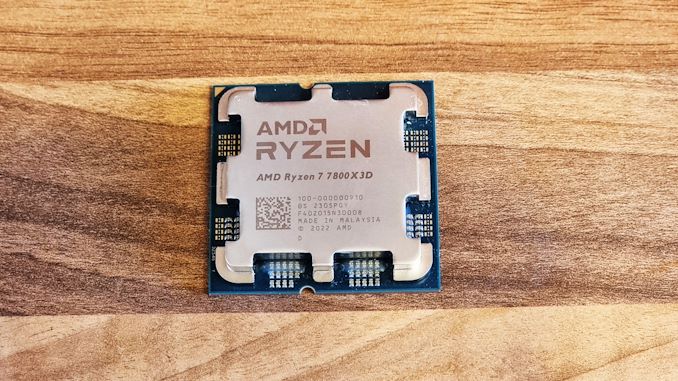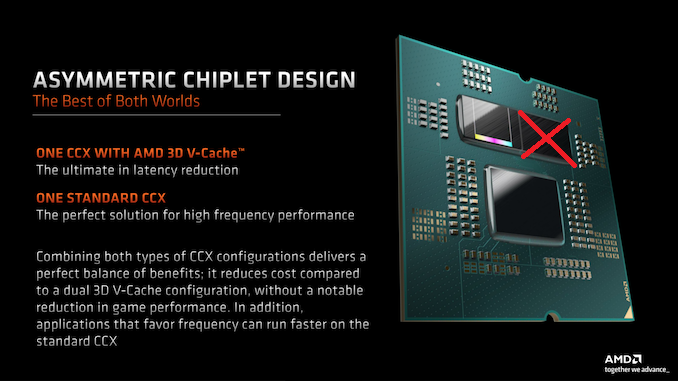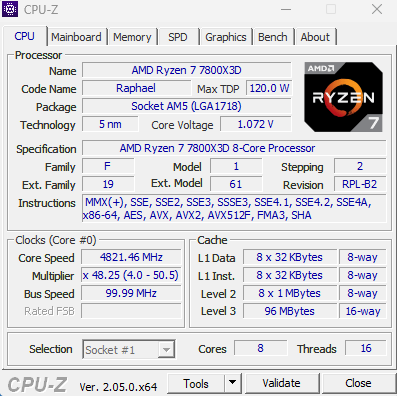The AMD Ryzen 7 7800X3D Review: A Simpler Slice of V-Cache For Gaming
by Gavin Bonshor on April 5, 2023 9:00 AM EST- Posted in
- CPUs
- AMD
- Zen 4
- AM5
- Ryzen 7000
- 3D V-Cache
- Ryzen 7 7800X3D

In February, AMD released the first parts in its highly anticipated Ryzen 7000X3D series. This new line combines AMD's 3D V-Cache packaging with high-performance and highly efficient Zen 4 cores. Two out of the three X3D series processors were available for the initial launch, including the flagship Ryzen 9 7950X3D and the slightly lower-spec Ryzen 9 7900X3D. However, AMD may have saved the best for last. Today, we will be looking at the third sibling from the Ryzen 7000X3D line-up, the long-awaited Ryzen 7 7800X3D.
The AMD Ryzen 7 7800X3D is the direct successor to last year's highly successful Ryzen 7 5800X3D, boasting 8 Zen 4 CPU cores, a base core frequency of 4.2 GHz, and a boost clock of up to 5.0 GHz. But what sets this processor apart from its predecessor is that it's using AMD's latest Zen 4 cores, built on TSMC's 5 nm node, which promises to take power and performance efficiency to the next level for gamers. Perhaps the biggest advantage of the Ryzen 7 7800X3D is its massive 96 MB of L3 cache, thanks to AMD's implementation of its 3D V-Cache packaging technology in cooperation with TSMC. Our reviews of the previous generation Ryzen 7 5800X3D and the behemoth Ryzen 9 7950X3D have shown this technology to be a success – sometimes, massively so – in specific games that are able benefit from the additional L3 cache.
Overall, the Ryzen 7 7800X3D appears to be a promising addition to the Ryzen 7000X3D lineup. Its impressive 96 MB of L3 cache and coming with the added benefits of Zen 4 cores make it a strong contender for gamers. However, it remains to be seen how it will perform in real-world applications compared to other current generation chips on test, as well as looking at how the performance in gaming stacks up.
AMD Ryzen 7 7800X3D: 8C/16T with 96MB of 3D V-Cache
As it stands, the AMD Ryzen 7 7800X3D is one of three 8-core SKUs within Ryzen 7000 series, with all three fairly dissimilar CPUs targeting different markets. The Ryzen 7 7700X ($341) offers an unlocked multiplier for overclocking, with a base TDP of 120 W and PPT of 142 W; it gives more power to the cores for more performance through AMD's Precision Boost Overdrive overclocking technology. Although the Ryzen 7 7700 ($329) has the same 8 x Zen 4 cores as the Ryzen 7 7700X, it benefits from a lower base TDP of 65 W and a PPT value of just 88 W at stock. This gives enthusiasts that want more affordable 8-core processor options for either higher stock performance with higher frequency and power levels or something with solid performance and exceptional power efficiency with a sub-100 W power output (from the CPU).
The third is the AMD Ryzen 7 7800X3D, which is primarily targeted at gamers and, in the right situations, can deliver exceptional gaming performance with its 3D V-Cache packaging technology. Looking to carry on from the success of its latest Ryzen 9 7950X3D ($699) and Ryzen 9 7900X3D ($599) with 3D V-Cache and build upon the success of last year's Ryzen 7 5800X3D, the Ryzen 7 7800X3D has some very interesting aspects to its design that make it stand out from the rest.
| AMD Ryzen 7000 Series Line-Up (as of 04/05/2023) | ||||||||
| AnandTech | Cores Threads |
Base Freq |
Turbo Freq |
Memory Support |
L3 Cache |
TDP | PPT | Price (Street) |
| Ryzen 9 7950X3D | 16C / 32T | 4.2 GHz | 5.7 GHz | DDR5-5200 | 128 MB | 120W | 162W | $799 |
| Ryzen 9 7950X | 16C / 32T | 4.5 GHz | 5.7 GHz | DDR5-5200 | 64 MB | 170W | 230W | $611 |
| Ryzen 9 7900X3D | 12C / 24T | 4.4 GHz | 5.6 GHz | DDR5-5200 | 128 MB | 120W | 162W | $589 |
| Ryzen 9 7900X | 12C / 24T | 4.7 GHz | 5.6 GHz | DDR5-5200 | 64 MB | 170W | 230W | $424 |
| Ryzen 9 7900 | 12C / 24T | 3.6 GHz | 5.4 GHz | DDR5-5200 | 64 MB | 65W | 88W | $430 |
| Ryzen 7 7800X3D | 8C / 16T | 4.2 GHz | 5.0 GHz | DDR5-5200 | 96 MB | 120W | 162W | $449 |
| Ryzen 7 7700X | 8C / 16T | 4.5 GHz | 5.4 GHz | DDR5-5200 | 32 MB | 105W | 142W | $349 |
| Ryzen 7 7700 | 8C / 16T | 3.6 GHz | 5.3 GHz | DDR5-5200 | 32 MB | 65W | 88W | $329 |
| Ryzen 5 7600X | 6C / 12T | 4.7 GHz | 5.3 GHz | DDR5-5200 | 32 MB | 105W | 142W | $249 |
| Ryzen 5 7600 | 6C / 12T | 3.8 GHz | 5.1 GHz | DDR5-5200 | 32 MB | 65W | 88W | $230 |
Touching on the main specifications of the Ryzen 7 7800X3D, it has 8 Zen 4 cores, operating within a base TDP of 120 W a maximum Package Power Tracking (PPT) value of 162 W. Interestingly, this is an increase in overall power from the Ryzen 7 5800X3D, which had a base TDP of 105.
Looking at things on a generational basis, both the Ryzen 7 7800X3D and Ryzen 7 5800X3D are 8 core designs. However, the Ryzen 7 7800X3D has the advantage of coming with the more performant and power-efficient Zen 4 cores, and from our reviews of AMD's Ryzen 7000 series processors, we've seen Zen 4 deliver on both fronts. At AMD's selected clockspeeds, Zen 4 has also shown to be more power efficient than competing chips from Intel's 13th Gen Core and previous 12th Gen Core series, which can reach higher performance levels, but burn a fair bit more power in doing so.
One major benefit of choosing the AMD Ryzen 7 7800X3D with its latest Zen 4 architecture over its predecessor, the Ryzen 7 5800X3D, is in terms of core frequencies. The previous model had a base clock of 3.4 GHz and a turbo of up to 4.5 GHz. Overclocking was also not supported by AMD, leading to some limitations in compute performance. The Ryzen 7 7800X3D boasts faster cores, with a 4.2 GHz base frequency (a 23% increase generationally) and a turbo of up to 5.0 GHz (an 11% increase in maximum clock speeds compared to the Ryzen 7 5800X3D). In our earlier review of the Ryzen 9 7950X3D ($699), which has two CCDs – one with 3D V-Cache and one without – we found that the clockspeed limitation 3D V-Cache-equipped Zen 4 chiplet is 5.0 GHz, as the CCD with 96 MB of L3 cache on the Ryzen 9 7950X3D also topped out at 5.0 GHz there (compared to the regular CCD boosting up to 5.7 GHz).
AMD Ryzen 7 7800X3D: One CCD to Rule Them All
Touching on the CCD situation with the Ryzen 7 7800X3D, unlike the other two V-Cache-equipped X3D Ryzen 7000 parts, the Ryzen 9 7950X3D and Ryzen 9 7900X3D, the Ryzen 7 7800X3D features one core complex die (CCD) and one centralized I/O die. This is in contrast to the 7900 series chips, which used two CCDs. To differentiate which each chip has in terms of cores, and CCDs, I've dissected both below:
- Ryzen 9 7950X3D: 2 x CCDs (8C/16T each), 1 x CCD /w 96 MB L3 Cache, 1 x CCD /w 32 MB L3 Cache
- Ryzen 9 7900X3D: 2 x CCDs (6C/12T each), 1 x CCD /w 96 MB L3 Cache, 1 x CCD /w 32 MB L3 Cache
- Ryzen 7 7800X3D: 1 x CCD (8C/16T), 1 x CCD /w 96 MB L3 Cache
With the launch of the AMD Ryzen 9 7950X3D, which we previously reviewed in February, it has two CCDs, one with the standard 32 MB of L3 cache and the other boosted with an additional 64 MB of 3D V-Cache layered on top (96 MB L3 in total). This design meant that AMD had to get creative to allow it to work so that the best levels of performance could be delivered in terms of both compute and gaming performance, avoiding sacrificing too much of either. With this, AMD brought out its PPM Provisioning and V-Cache Performance Optimizer drivers that work with Microsoft's Windows 11 (and 10) operating system to leverage whichever CCD best suits the task.
Working in tandem with Microsoft's 'Game Mode' built into the operating system, when a game is loaded up on the Ryen 9 7950X3D, Game Mode would detect this and feed the information to the Provisioning driver. AMD's drivers, in turn, would deprioritize and park non-V-Cache enabled CCD, pushing everything to run from the CCD with the 96 MB of 3D V-Cache. The second CCD could be fired back up if enough work necessitated it (albeit still at a lower priority), but ideally, AMD tries to avoid this so that game threads aren't regularly passing data between the two non-homogenous CCDs.

The Ryzen 7 7800X3D is essentially the Ryzen 9 7950X3D with just one CCD (7950X3D has two)
Otherwise, when running a highly threaded non-game workload such as video rendering, the chip would behave more normally, making all 16 cores available and prioritizing the vanilla CCD. In this case, the V-Cache CCD was essentially a second set of slightly lower clocked Zen 4 cores.
Moving back to the Ryzen 7 7800X3D, one would be right in thinking that it's basically just the 3D V-Cache CCD of the Ryzen 9 7950X3D without the higher spec CCD with the faster Zen 4 cores. This greatly simplifies the scheduling process, as the single, homogenous CCD means that no special actions are needed to account for the extra L3 cache.
Ultimately, AMD has created a sort of two (and a half-ish) tiered system with its Ryzen 7000X3D lineup The Ryzen 9 7950X3D can offer the best of both worlds, with faster cores of up to 5.7 GHz on one CCD for those heavy compute workloads such as video rendering and content creation. At the same time, the Ryzen 7 7800X3D offers plenty of grunt with 8C/16T. Ideally, it can still deliver top-tier gaming performance through the combination of Zen 4 cores and 3D V-Cache, but with at a 36% lower price ($699 vs. $449).

AMD Ryzen 7 7800X3D screenshot from CPU-Z
Looking at the current desktop processor landscape concerning the Ryzen 7 7800X3D, there's a lot of competition from AMD's own stack in the sub-$500 arena. This includes AMD's own Ryzen 7 7700X ($349), which is also an 8C/16T SKU. It has faster cores (up to 5.4 GHz) and fully supports overclocking. Another option is the Ryzen 7 7700. Although the Ryzen 7 7700 is a lower-powered 8C/16T part and doesn't benefit from the 3D V-Cache for those games that can leverage it, it also supports overclocking and is ultimately cheaper at $329.
As for AMD's competition, the AMD Ryzen 7 7800X3D is up against Intel's 13th Gen Core series, specifically the Core i9-13900K and Core i7-13700K. While the Core i7-13700K is in the same price range as the Ryzen 7 7800X3D, it's worth noting that we didn't receive a sample of this particular Intel processor for testing. Instead, we reviewed the Core i9-13900K and Core i5-13600K at their launch in October of last year.

AMD Ryzen 7 7800X3D packaging (no stock cooler is provided)
Both of the Intel processors mentioned earlier should offer better compute performance than the Ryzen 7 7800X3D because, in part, they have more cores. However, AMD is rather specifically targeting gamers with the Ryzen 7 7800X3D, so the biggest competition is in the gaming space, where going beyond 8 CPU cores is rarely beneficial right now. We've tested the Core i9-13900K and Core i5-13600K at 1080p, 1440p, and 4K resolutions. Surprisingly, the cheaper Core i5-13600K (14C/20T) performed well, indicating that at higher resolutions, graphics card performance is more critical than CPU power in achieving higher framerates.
The AMD Ryzen 7 7800X3D is a good choice for gamers who don't require cutting-edge compute performance or need to create content. It's also $250 cheaper than the Ryzen 9 7950X3D, leaving extra budget for a better graphics card, which can enhance the gaming experience. The main questions people have are how the Ryzen 7 7800X3D compares to the competition and how it stacks up against the previous Ryzen 7 5800X3D, especially considering its price of $449. In this review, we'll answer both questions.
The Current CPU Test Suite
For our AMD Ryzen 7 7800X3D testing, we are using the following test system:
| AMD Ryzen 7000 Series System (DDR5) | |
| CPU | Ryzen 7 7800X3D ($449) 8 Cores, 16 Threads 120 W TDP |
| Motherboard | GIGABYTE X670E Aorus Master (BIOS 301) |
| Memory | G.Skill Trident Z5 Neo 2x16 GB DDR5-5200 CL44 |
| Cooling | EK-AIO Elite 360 D-RGB 360 mm AIO |
| Storage | SK Hynix 2TB Platinum P41 PCIe 4.0 x4 NMve |
| Power Supply | Corsair HX1000 |
| GPUs | AMD Radeon RX 6950 XT, Driver 31.0.12019 |
| Operating Systems | Windows 11 22H2 |
Our updated CPU suite for 2023 includes various benchmarks, tests, and workloads designed to show variance in performance between different processors and architectures. These include UL's latest Procyon suite with both office and photo editing workloads simulated to measure performance in these tasks, CineBench R23, Dwarf Fortress, Blender 3.3, and C-Ray 1.1.
Meanwhile, we've also carried over some older (but still relevant/enlightening) benchmarks from our CPU 2021 suite. This includes benchmarks such as Dwarf Fortress, Factorio, and Dr. Ian Cutress's 3DPMv2 benchmark.
We have also updated our pool of games going forward into 2023 and beyond, including the latest F1 2022 racing game, the CPU-intensive RTS Total War: Warhammer 3, and the popular Hitman 3.










52 Comments
View All Comments
shabby - Wednesday, April 5, 2023 - link
Seems like the 7600x is the clear winner here.meacupla - Wednesday, April 5, 2023 - link
You should go see the results from other review sites as well.Anandtech's testing configuration seems to be bottlenecked in a way that makes the 7600X look faster than it really is.
7800X3D blows the 7700X and 7600X out of the water on other review sites.
CoachAub - Saturday, April 15, 2023 - link
I agree. The memory chosen 5200 44CL is not ideal and affects scores. They need DDR5-6000 at 30CL which is the sweet spot.Violet Giraffe - Monday, April 24, 2023 - link
A memory kit that costs almost as much as the CPU? I doubt this what many Ryzen 7000 buyers will run, at least in the near future. This why I'm inclined to go for Intel 13xxx, despite their higher power draw.army165 - Tuesday, May 16, 2023 - link
I picked up 32GB's of GSkill 6000mhz, 30CL for $120. I don't know where you saw that RAM was $450 but it's not.godrilla - Wednesday, April 5, 2023 - link
especially if you want to save money and buy a better gpu for eg.AMD Ryzen 5 7600X, MSI B650-P Pro WiFi, G.Skill Flare X5 16GB DDR5-5600 Module, Computer Build Combo
is$533.96 SAVE $133.97
$399.99 before 5% membership discount at microcenter. The difference saved can go from a 6700xt to a 6950XT which is going for $549 with cpu Combo and should easily double them frames.
Anoldnewb2 - Wednesday, April 5, 2023 - link
Who would use such crappy memory 5200 cl 46 in a new build? For example at Microcenter you can get G .Skill Flare X5 Series 32GB (2 x 16GB) DDR5-6000 PC5-48000 CL36 for $140Wereweeb - Wednesday, April 5, 2023 - link
Ryzen 7000 only officially supports DDR5 speeds of up to 5200MT/s. Anything above that is overclocking and outside of their specifications.Anoldnewb2 - Wednesday, April 5, 2023 - link
And who doesn't use PBO with their memory?Anoldnewb2 - Wednesday, April 5, 2023 - link
I meant AMD EXPO memory profiles. If your reading this site, your probably interested in getting more performance from your system. also CL 46 is so slow